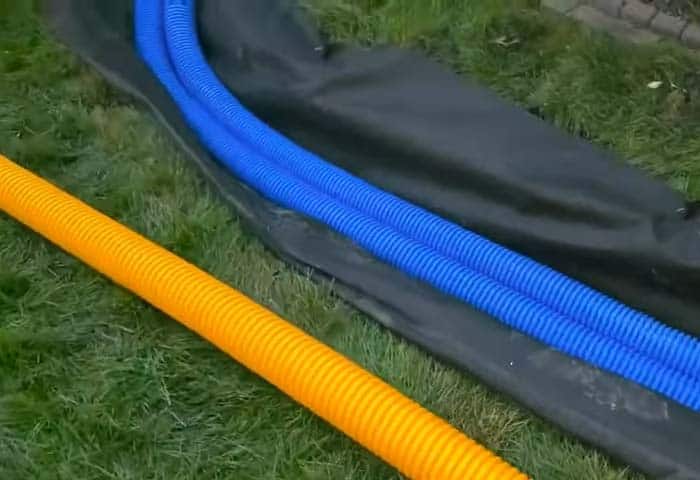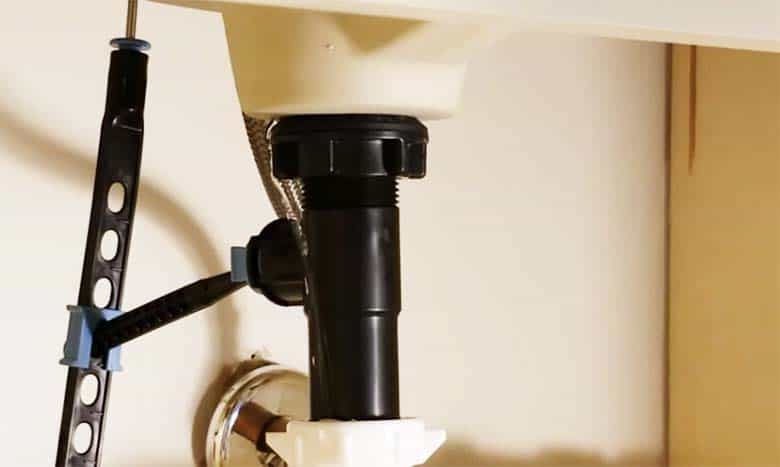You are building or renovating your driveway and suddenly find the necessity of installing the drainage under it. While installing the drainage system under the driveway isn’t tough, choosing the right pipe for it is the hardest part.
So, what type of drainage pipe to use under the driveway? You might stand in the plumbing store and wonder about this question while installing a drainage pipe under the driveway. It will help you know about the driveway culvert pipe better.
Ideally, you should use PVC or corrugated drainage pipes to install under the driveway. These are the toughest pipes in the market and have greater flexibility and improved drainage capacity. So, you won’t have to worry about passing your automobile over their install area and clogging the home entrance on the driveway.
Now, let’s take this discussion deep and see what to look for in drainage under the driveway.
What Type of Drainage Pipe To Use Under Driveway?
When installing the drainage pipe for the driveway, you must choose the outdoor drainage pipes, not the ones built for indoor use. Nonetheless, two of the most popular and acceptable drainage pipes under the driveway are PVC and corrugated pipes. So, we will focus on these two types of drainage pipes and see the outcome to help you finalize your decision.
1. PVC Drainage Pipe:

PVC drainage pipes are found widely in every home for indoor and outdoor drainage systems. If you have a driveway and need to build a drainage system under it, you can choose the PVC pipes without any doubt.
PVC pipes are synthetic plastic polymers and have a pretty generic rule. Also, these pipes are rigid and easy to clean in the long run. These two features make the PVC pipes ideal for exterior drainage, where they need to withstand external weather and consume more residues and debris than indoor pipes.
There’re many types of PVC pipes that you can choose from for the drainage under the driveway. It includes:
- PVC-U pipes refer to unplasticized PVC pipes. So, these pipes don’t have any plastic material in them. The PVC-U pipe is pretty rigid and long-lasting, which makes them an ideal choice for driveways.
- The C-PVC pipes stand for chlorinated PVC pipes and are also used under driveways in many homes. Its impact, corrosion resistance, durability, and reliability make the C-PVC pipes suitable for driveway drainage installation.
- PVC-O pipes are an improved version of PVC-C pipes that boast better performance and durability in extreme conditions. These pipes have a better impact, hydraulic, and wear resistance, making them ideal to withstand the heavyweight automobiles under the driveway.
2. Corrugated Drainage Pipe:

Corrugated drainage pipes have multiple grooves and ridges. These grooves and ridges will run parallel to where you install them. Their grooves and ridges make them perfect for bends and joints and are preferable for the outdoor drainage system.
If you plan for an easy drainage installation under the driveway and at an affordable cost, corrugated pipes can be an excellent solution.
One of the most popular corrugated pipes for drainage is the HDPE/N 12 corrugated dual-wall drainage pipes. As the name suggests, this pipe has high-density polyethylene, among the strongest plastics. Thus, the HDPE/N 12 pipes have excellent rigidity and strength.
The exterior wall focused on rigidity to withstand weights, external elements, and weather. On the contrary, the interior wall offers good steadiness and flexibility to carry the water to the sewer line or main draining point.
3. Perforated Drain Pipe Under Driveway:

Corrugated pipes can be perforated or solid. Similarly, PVC pipes can be perforated too. With improved drainage, these pipes are widely accepted for removing rainwater from outdoor home spaces such as yards and lawns.
Since these pipes are designed to remove rainwater, they are suitable for driveways, too, due to their improved draining capacity, rigidity, and performance.
Perforated pipes have tiny holes and slots around their entire surface. These holes allow effortless entry and exit of water, improving the drainage system. Since it can effortlessly take water in on all sides, perforated pipes can drain more than PVC pipes. It is ideal for the rainy season and under the driveway, where you expect your drainage system to deliver the best performance.
When to use perforated drain pipe?
A perforated drain pipe is made to drain rainwater and excess water from outdoor locations of your home to keep it dry and clean. It will offer improved drainage and reduce the possibility of standing groundwater. Thus, it helps maintain the property conveniently.
If you live in a region with many rain showers, you can install the perforated drain pipes under the driveway to easily remove excess water. However, you need to remember that perforated pipes are slightly harder to clean and unclog. Therefore, you may need to maintain them more extensively. Thankfully, the perforated drainage pipe is the cheapest and is easy to replace if need be.
Factors to Look At For Drainage Pipe Under Driveway
Now that you know what type of drainage pipe under the driveway is useful, you need to check a few facts. Yes, you can’t just pick any pipes for driveway drainage from our suggestions and expect them to deliver the best performance. You must consider the weight of your vehicle, expected drainage water amount, and exterior temperature.
Temperature Changes:
Extreme high or low temperatures can affect the performance of the drainage pipe. Usually, in cold seasons when the temperature shrinks close to or below the sub-zero temperature, it becomes hard for PVC pipes to resist wear and tear. Thus, frozen water might damage these pipes. In this regard, perforated pipes with tiny holes can be better. So, you should consider the temperature change in your locality and choose the pipe accordingly.
Amount of Drainage Water:
The amount of water you expect the drainage pipe to remove will also affect which pipe you should choose. Also, it will determine the size and diameter of the drain pipe. For instance, a ½” PVC pipe can drain more water than a 5/8” drain pipe due to its bigger diameter and size.
The Weight of Your Vehicle:
Since the draining pipe will be right under your driveway, you need to consider its weight-bearing capacity. It is vital because your vehicle will pass over the driveway multiple times a day, and the pipe will need to withstand the weight.
The weight of a vehicle may vary from 2500 pounds to 4500 pounds. It depends on the type of vehicle you have. So, whether you choose PVC, perforated, or corrugated drainage pipes for driveways, ensure that the material can take the vehicle’s weight for years. Or else, you will need to replace the pipe soon, which can be costly and frustrating.
How To Run Drainage Pipe Under Driveway
A driveway drainage pipe is also known as a driveway culvert pipe. It runs horizontally under the driveway and ends in a draining ditch. So, you will find it under a channel drain or trench drain. It usually carries the water from the nearby yard and roads to the draining point where it finally gets to the soil.
Here we will briefly discuss the process of installing drainage pipe under the driveway. So, let’s head to it.
You will need:
- A shovel
- A trench digging machine
- A driveway drainage pipe
- Gravel
- Drain grate
The installation steps of the driveway drain culvert follow the below steps.
Step 1: Outline the draining plan
You should measure and outline the driveway culvert draining properly. You should use the measuring tape to measure how deep and long the pipe should be correct. It shouldn’t be too close to your home foundation or the road. Also, it shouldn’t be too up and visible from the ground.
Step 2: Create the trench
Once you have measured how deep the trench needs to be, start digging it. Smaller driveways with creek and gravel can be dug out with a shovel. However, you will need to use the trench-digging machine if you need to dig a deeper and longer trench.
If you don’t have the trench digging machine at home, you can call a plumber or construction worker for it. They will dig the trench for you with their professional digging machine. Also, smoothen the trench surface to sit in the draining pipe. Lastly, you should look for any objects that might damage the pipe inside the drainage and remove them carefully.
Step 3: Install the pipe
When you have prepared the trench, you should lay the draining pipe slightly. The angle will help the pipe drain naturally without working against gravity. If you need a longer drainage system, you may need to install concrete drainage.
On the contrary, we suggest you choose the PVC or perforated drainage system for a shorter drainage system. Also, install the debris filter on both sides of the pipe to stop clogs. It will help the pipe last longer without extreme maintenance.
Now, you will need to rebury the pipe. Before reburying the pipe, apply gravel around it to improve the drainage facility and protect the pipe.
When you have applied the gravel, bury the pipe using dirt. Finally, put on the asphalt or gravel for the driveway surface.
Frequently Asked Questions:
What is the pipe under a driveway called?
Usually, the black corrugated or drainage pipe under the driveway is called a driveway culvert. It is named so because it works like a traditional ditch to drain water.
Should I use a perforated pipe for drainage?
Yes, you may use the perforated pipe for drainage. It will improve the drainage system in your outdoor location and is used to collect and drain excess and rainwater.
Final Words
You should now clearly know what type of drainage pipe to use under the driveway to improve the drainage system and get a long-lasting performance from the pipe. You may choose perforated or PVC pipes for shorter distances and concrete ones for longer distances. Also, installing the drainage pipe under the driveway should be easy with your guideline.
I am James Martin, An professional plumber with more than 16 years of experience. The main purpose of my writing is to share my experiences of helping others. Be with me and explore bathroom plumbing, installation, cleanness ideas, and many more.




